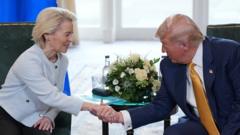In a major breakthrough, the United States and the European Union have finalized a trade agreement that resolves months of tension between the two economic heavyweights. Following intensive discussions in Scotland, US President Donald Trump and European Commission President Ursula Von der Leyen agreed to a blanket tariff of 15% on all European goods entering the US market. This new rate is a significant reduction from the 30% Trump had previously threatened to impose.
During a visit to Scotland, Trump expressed optimism about the deal, asserting that it would strengthen ties between the US and the EU, which collectively represent one-third of global trade. In return for this tariff structure, Von der Leyen noted that European nations would grant American exporters exemptions on certain products, providing additional economic opportunities.
Trump's approach to trade has been one of confrontation, aiming to reduce the US trade deficit and recalibrate American economic relationships globally. Alongside the EU agreement, Trump's administration has also negotiated similar tariff approaches with countries such as the UK, Japan, and Vietnam. However, the ambitious goal of securing 90 trade agreements in 90 days remains unmet.
The landmark agreement was announced after a private meeting at Trump's Turnberry golf course, where both leaders described the negotiations as challenging but ultimately rewarding. Trump stated, "We have reached a deal. It's a good deal for everybody," while Von der Leyen emphasized its potential to foster stability for both nations.
Under the terms of the deal, it is expected that the EU will invest approximately $600 billion in the US economy and purchase significant military resources, aiming to consolidate energy security and reduce dependencies on Russian supplies. Von der Leyen thanked Trump for his strong commitment to achieving this agreement, highlighting the complexities involved in the negotiations.
Although Trump's existing global tariffs on steel and aluminum will remain, both parties view this agreement as a notable victory, mitigating the potential impact of higher tariffs on European products, which could have adversely affected various sectors such as pharmaceuticals and agriculture.
Trade between the US and the EU reached roughly $975.9 billion last year, complicating the landscape of tariffs and trade balances. Trump's focus on rebalancing these figures suggests continued scrutiny of trade relationships as both regions move forward from this recent resolution. In upcoming days, British Prime Minister Keir Starmer is set to meet with Trump to discuss further economic collaborations.
During a visit to Scotland, Trump expressed optimism about the deal, asserting that it would strengthen ties between the US and the EU, which collectively represent one-third of global trade. In return for this tariff structure, Von der Leyen noted that European nations would grant American exporters exemptions on certain products, providing additional economic opportunities.
Trump's approach to trade has been one of confrontation, aiming to reduce the US trade deficit and recalibrate American economic relationships globally. Alongside the EU agreement, Trump's administration has also negotiated similar tariff approaches with countries such as the UK, Japan, and Vietnam. However, the ambitious goal of securing 90 trade agreements in 90 days remains unmet.
The landmark agreement was announced after a private meeting at Trump's Turnberry golf course, where both leaders described the negotiations as challenging but ultimately rewarding. Trump stated, "We have reached a deal. It's a good deal for everybody," while Von der Leyen emphasized its potential to foster stability for both nations.
Under the terms of the deal, it is expected that the EU will invest approximately $600 billion in the US economy and purchase significant military resources, aiming to consolidate energy security and reduce dependencies on Russian supplies. Von der Leyen thanked Trump for his strong commitment to achieving this agreement, highlighting the complexities involved in the negotiations.
Although Trump's existing global tariffs on steel and aluminum will remain, both parties view this agreement as a notable victory, mitigating the potential impact of higher tariffs on European products, which could have adversely affected various sectors such as pharmaceuticals and agriculture.
Trade between the US and the EU reached roughly $975.9 billion last year, complicating the landscape of tariffs and trade balances. Trump's focus on rebalancing these figures suggests continued scrutiny of trade relationships as both regions move forward from this recent resolution. In upcoming days, British Prime Minister Keir Starmer is set to meet with Trump to discuss further economic collaborations.




















